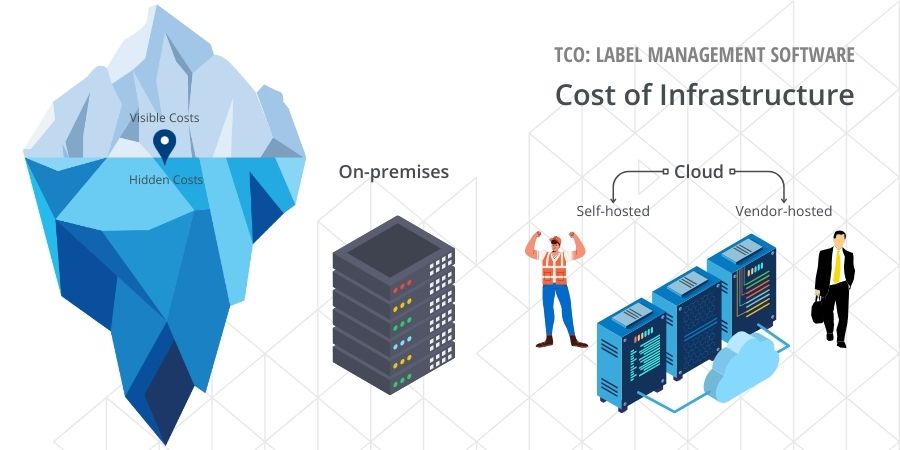Válassza ki tartózkodási helyét és nyelvét, hogy a legjobb felhasználói élményben legyen része
Válassza ki tartózkodási helyét és nyelvét, hogy a legjobb felhasználói élményben legyen része

When it comes to software, one size doesn’t fit all. Especially when deciding between on-premises and cloud solutions. While cloud is a hot topic and often the default choice for many businesses, on-premises software still offers many compelling benefits. On-prem is the better fit for businesses that prioritize data control, security, and long-term stability.
I want to talk to a labeling expert
If your business isn’t fully committed to a cloud-first IT infrastructure strategy or if data regulations don't require a cloud deployment, it’s worth considering how on-premises solutions could better serve your needs.
On-premises software means your IT infrastructure (your hardware and software) is hosted on-site and managed in-house, rather than at a remote location or by a third-party vendor. Whereas cloud solutions are typically hosted externally, limiting direct control over data and systems. Both options can be secure, but the difference lies in how much control and customization you have. TEKLYNX is known for giving businesses the power to choose. We don’t force our customers to the cloud; we let them decide what works best for them.
As mentioned above, on-premises means hosting your solutions on-site. It’s ideal for businesses with custom hardware, specific workflows, or strict data security requirements, such as those in healthcare or government. It gives organizations more control over their IT environment and greater flexibility for customization. With on-premises hosting, your software runs on local servers managed by your internal IT team. This in-house setup allows you to configure, secure, and optimize your systems exactly the way you need; something that is often limited with cloud deployments.
However, when you choose on-premises, you can still communicate locally with cloud-based devices in your network, offering the best of both worlds.
Everyone's talking about the cloud and while it may seem like a more modern choice, it still has some downsides. Cloud software operates on a subscription model where end users pay recurring fees to access the software hosted by a third-party vendor. For some, the “pay-as-you-go” model is more attractive due to the lower upfront cost vs. a one-time fee. However, it requires ongoing budget planning with long-term financial commitment.
Another difference between on-premises and cloud is the cost of software upgrades. Software upgrades are necessary to maintain security and ensure the software will continue to work with the latest technology and operating system. The process of upgrading your software depends greatly on how it is hosted. For example, cloud upgrades often happen automatically without oversight, while on-premises upgrades are planned, tested and rolled out carefully. Read more about the cost of label management software upgrades in our blog.
Just because you choose on-premises doesn’t mean you forgo all cloud services. You can still interact with cloud-based solutions; your software will just be locally installed. For example, with enterprise label management, you can have a centralized server paired with localized print engines. Or you can leverage a browser-based software solution that lets you log in from any device and print barcode labels, avoiding the need for multiple print stations.
Now that you understand the ins and outs of on-premises, you are probably wondering how else you can benefit from it. If you choose on-premises, you can also take advantage of:
Even though on-premises may seem old-fashioned, it has its perks.
One of the biggest benefits for on-premises is the chance of a lower total cost of ownership (TCO). TCO is the total cost of a solution over its lifespan. For label management solutions, this includes the software purchase, implementation costs, ongoing support costs, and ongoing maintenance costs. Much of the TCO is set by the software vendor, such as the software price and hourly rate for related services. Some of the TCO can be influenced by the buyer, including labor costs, infrastructure costs, and training costs.

Read our blog to learn more about infrastructure costs and how to compare on-premises costs to cloud costs.
For some, cloud might make more sense if you are a startup with limited IT resources, have a team that needs remote access from anywhere, or your company is scaling rapidly and needs flexibility.
But maybe there’s an option where you can have both.
A hybrid approach is the perfect middle ground. A hybrid approach combines the control and security of on-premises but with the flexibility of cloud-based solutions. Rather than fully moving to the cloud, which introduces data privacy, internet dependency, and long-term cost concerns, the hybrid model allows businesses to use both public and private cloud environments by keeping critical systems and sensitive data in-house but leveraging cloud capabilities.
One TEKLYNX customer uses API printing within CODESOFT, our advanced barcode label design solution. They have 45 workstations plugged into local printers. By building a custom website that sends browser-based print requests to CODESOFT, they created a system where a centralized server (cloud) communicates with localized print engines (on-premises), combining the best of both environments.
While cloud solutions offer flexibility and convenience, on-premises software provides greater control, customization, security, and long-term value. It's especially valuable for industries that have strict compliance requirements or complex IT environments. If your business values data ownership, customizable infrastructure, and predictable costs, an on-premises deployment may be a more strategic choice.
Ultimately, the better fit depends on your business’ needs and industry requirements. Once you understand the benefits, you can make an informed decision about what is right for your business. And with TEKLYNX, we give you the option to choose what suits your business best. If you need help deciding, get in touch with a labeling expert who can help you through the decision process.
Get in touch with a labeling expert
Anthony Bieniewski is the Operations and IT Manager at TEKLYNX. Anthony uses his 15+ years of experience in IT infrastructure and security to continue to move TEKLYNX forward with efficient and secure processes and tools. He also leverages that experience in mentoring and coaching TEKLYNX’s support team so that they can continue to pursue best practices when helping our customers barcode better.
A well-functioning labeling system is an important part of operational efficiency because it impacts nearly every part of your supply chain. An outdated labeling system can lead to misprints, noncompliance, and slow production. This blog covers how to evaluate your labeling system. We’ll dive into the questions to ask and how to determine if your labeling system has room for improvement.
READ MORE
Mergers and acquisitions (M&A) are major drivers of economic activity in the global economy. In a post-COVID world, M&A has remained a key strategy for business leaders seeking efficiency, profitability, and a competitive edge.
As M&A deals play out across industries, IT leaders are faced with the challenge of consolidating technology. In this blog, we’ll explore 5 steps to consolidate labeling systems after mergers and acquisitions. These strategies can be used by any organization with disparate labeling systems, whether part of a merger or not.
This blog will highlight how businesses can optimize labeling practices to align with the triple bottom line framework. Companies can drive ethical, sustainable, and profitable growth by focusing on the interconnected areas of people, planet, and profit.
READ MORE
Total Cost of Ownership (TCO) is a helpful concept for making business purchase decisions. TCO includes the upfront cost, related costs, and estimated ongoing related costs throughout the useful life of the purchase.
TCO is often compared to an iceberg because the obvious costs, like the tip of the iceberg, represent only a small portion of the total. Many costs are hidden beneath the surface, just like the true size of an iceberg is hidden underwater. A detailed TCO analysis can help reveal the full "iceberg," ensuring you're prepared for all costs—not just the obvious ones.
READ MORE© Copyright 2025 TEKLYNX CORPORATION SAS. Minden jog fenntartva.
What do you think? Leave us a comment.
Comments will be reviewed and are subject to TEKLYNX’ comment policy. Your email address will not be published publicly.